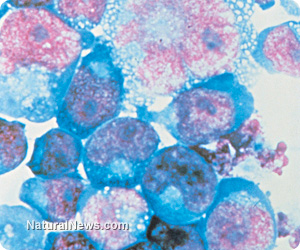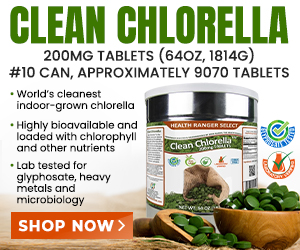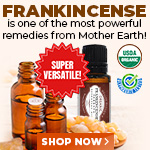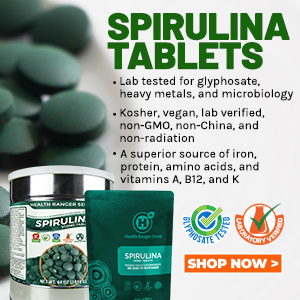
Control your telomeres to earn positive marks on your genetic spellchecker
Friday, September 13, 2013 by: Cody L
Tags: telomeres, genetic spellchecker, health biomarkers
- Newly released JFK files reveal Pentagon's role in creating Lyme disease and covid in the same lab
- Oncologist warns of ‘terrifyingly aggressive’ cancers in children, linked to immune suppression from COVID vaccines
- NIH study, buried for decades, reveals that Flu Shots INCREASE elderly deaths, not prevent them
- Trump administration CUTS FUNDING to Gavi, the Vaccine Alliance - a major blow to the Bill Gates-backed entity
- Health Ranger Report: Ashton Forbes discusses TELEPORTATION ORBS and their role in MH370 disappearance
- Musk targets “strangely wealthy” lawmakers in DOGE probe, names Pelosi, McConnell, Schumer
- COVID-19 scandal linked to CANCER SURGE: Billionaire researcher sounds alarm
- Millionaire fitness coach charged in Tesla vandalism incident as anti-Musk attacks escalate
- “Ethically sourced” human “bodyoids” could usher in a new era of medical exploitation, raising disturbing ethical questions
- DARPA: The shadowy innovator behind the world’s most advanced military technologies
- Ancient kitchen secrets REVEALED: How garlic, ginger and green onions fight cancer and heart disease
- EPA banned chemical linked to cancer, Parkinson's and fatal heart defects in babies - now industry is lobbying to get it reinstated
- Woman contracts WORLD'S DEADLIEST VIRUS after unknowingly being given the WRONG VACCINE
- RFK Jr. is pushing Big Pharma ad ban - and corporate media is panicking
- Tackling the rubber waste crisis: Groundbreaking study reveals eco-friendly method to recycle tires
- Homesteading Boom: How families are escaping cities to grow their own food
- Civil war is here – Multiple events, from conservatives being “swatted,” to attacks against Telsa owners, happening across America as Dem politicians are telling supporters to ‘fight in the streets”
- NYT admits U.S. ran Ukraine war operations-Russia's victory exposes obsolete NATO tactics, says Mike Adams
- Newly released JFK files reveal Pentagon's role in creating Lyme disease and covid in the same lab
- Analysis: The coming economic collapse, a mass uprising and Trump's three secret weapons to halt the growing revolt
- Trump's greatest betrayal so far: Accelerating Middle East wars, silencing dissent, and serving Zionist masters
- CDC finally halts $11 billion COVID funding scam as health officials admit the ‘pandemic’ was a fraud
- The hidden dangers in your kitchen: How cooking methods impact diabetes, cancer and aging
- Kiss Your Genetic Privacy Good-Bye! 23andMe Gets Green Light to Sell Your Intimate Genetic Details to Anyone They Want
- DEADLY DECEPTION: How COVID vaccines increased mortality rates and why authorities hid the truth
- Dr. Suzanne Humphries makes bombshell appearance on Joe Rogan podcast, exposing vaccine industry deception back to POLIOMYELITIS
- Trump nominates VACCINE ZEALOT Susan Monarez to lead the CDC, sidelining RFK Jr.'s reform efforts
- Here are TEN all-natural ways to protect your garden without using harmful chemicals
- Woman contracts WORLD'S DEADLIEST VIRUS after unknowingly being given the WRONG VACCINE
- Senate Democrats deny censorship industrial complex existed, defend government's role in silencing dissent
- Black cumin seed oil emerges as a powerful ally against breast cancer and chronic inflammation
- Sugar-free deception: Artificial sweeteners hijack hunger signals, fuel obesity epidemic, study warns
- “Independent” anti-Russia outlet MEDUZA faces COLLAPSE as US funding dries up
- The Health Ranger releases “Vaccine Zombie” song and music video, using AI-animated zombies for the music video
- Discovery of vast underground city beneath Giza pyramids challenges human history
- Key nodes of Federal Government censorship
- Newly released JFK files reveal Pentagon's role in creating Lyme disease and covid in the same lab
- California's social media censorship law struck down: A victory for free speech or a threat to online safety?
- EPA advisor admits the agency is funneling billions to climate groups ahead of Trump’s return to White House
- The Health Ranger releases “Vaccine Zombie” song and music video, using AI-animated zombies for the music video
- Dr. Mike Yeadon releases 15-minute testimony - WATCH - about genocidal intent of COVID “vaccines”
- Florida takes a stand: DeSantis proposes permanent ban on mRNA vaccine mandates
- “Why we influenced the 2020 elections”: Facebook files reveal the coordinated effort to bury the Hunter Biden laptop story
- Mike Adams releases country western hit single: Goin’ Back in Time is Comin’ Home
- The pandemic as a tool for INDOCTRINATION: Understanding “The Indoctrinated Brain” by Dr. Michael Nehls
- Unpacking the Lies That We’ve Been Fed – new song and music video released by Mike Adams, the Health Ranger
- Mike Adams releases music poetry sensation: A Child of God
- House Intelligence Committee calls for the ARREST and PROSECUTION of Dr. Anthony Fauci
- Rep. Nancy Mace introduces bill to ban biological males from female facilities on federal property
- Michigan sheriff announces criminal investigation into 2020 election crimes, Dominion Voting Systems
- Peter Rost exposes Big Pharma corruption in his book “The Whistleblower: Confessions of a Healthcare Hitman”
- Migrants are taking advantage of recent hurricanes to scam residents and loot their homes
- Sugarcane extract superior to cholesterol-lowering drugs?
- Survival 101: Effective EMF blocking techniques
- Red Cross issues warning to stop blood plasma donations from vaccinated people
- Scientists confirm: GENIUS brain function can be spontaneously unleashed in humans without any apparent cause
- EPA advisor admits the agency is funneling billions to climate groups ahead of Trump’s return to White House
- HYSSOP: What research reveals about the health benefits of this ancient holy herb
- Two containers with completed ballots fall out of truck in Florida
- Fully vaccinated about to see “tsunami” of illness and death, warns virologist
- Global leaders unite to clamp down on “misinformation” with UN-backed Cascais Declaration
- BREAKING: 2025 NDAA authorizes mandatory military draft of WOMEN across America… as Pentagon pursues global NUCLEAR war with both Russia and China at the same time
- Michael Yon warns of a ZIONIST TAKEOVER in Trump’s second administration
- BOMBSHELL: DNA testing kits are a SCAM to develop ethnic-specific bioweapons
- Ozempic and Wegovy weight loss drugs are injectable LIZARD VENOM PEPTIDES that may unleash a devastating wave of organ failure… side effects align with symptoms of SNAKE BITES
- Israeli soldiers accused of even more torture and abuse in the West Bank
- These 13 countries just signed an agreement to engineer a global FAMINE by destroying food supply
- NASA admits that climate change occurs because of changes in Earth’s solar orbit, and NOT because of SUVs and fossil fuels
- RFK Jr. clears key hurdle: Sen. Susan Collins backs controversial HHS nominee, signaling a new era for health policy
- Sermon 30: How Jesus reveals Caesar’s FAKE CURRENCY and FALSE AUTHORITY
- Coriander seeds: Ancient medicine backed by modern science
- Arizona officials claim Maricopa County needs 10-13 days to tabulate results of the election
The eye of the beholder
Anti-aging biomarkers called peripheral leukocyte (white blood cell) telomeres are structures composed of nucleotide sequences which cap the ends of chromosomes, safeguarding dividing cells from degradation and ensuring the protection of our genome. Collectively, all things healthy for telomeres are called geroprotectors. Our varying socioeconomic conditions and modern standards of living set a high demand on our sources of dietary, social and exercise-based geroprotection. Some sources of genotoxicity include smoke, acrylamide in French fries, heavy metals, radiation and psychological stress. Many people in need are tobacco smokers, overweight, physically inactive, low in vitamin D and blood plasma antioxidants, psychologically stressed, depressed, working night shifts or otherwise finding ways to shorten their telomere length. Telomere shortening was even discovered in women living nearby waste landfill sites. Empathizing for those in need causes a quantifiable change in our white blood cell telomeres. If we help people before we judge them, it may determine whether our telomeres shorten, which is bad, or lengthen, which is good. So what we really have here is a unified responsibility to curtail these burdens for geroprotection in our ecology.Myriad modulators
Fortunately, we have the capacity to decelerate the shortening and replenish the activity of telomere reverse transcriptase, or TERT, the enzyme responsible for countering telomere shortening, keeping them in higher functionality. The difference is eliminating up to 20 years of accelerated biological aging. Keeping lights off after the sun goes down is one way to control brain melatonin levels, which can facilitate psychoneuroimmunological control, that is to say, a "thought-based grip" that enhances white blood cell functionality. A certain formula is circulating on the internet for $1,000 a bottle claiming to treat accelerated aging by preventing telomeric shortening. Certainly there are other options. Alpha carotene plasma levels independently predict lifespan. Dietary fiber ferments into butyrate which regulates geroprotective complexes around our DNA. The Rasayanas of Ayurvedic medicine coupled with the anti-aging plants in Traditional Chinese Medicine could be less expensive. There are also methods of relieving systemic inflammation with stimulation of acupoints with common red light pointer lasers.Five worthy recommendations
1) Antioxidants/Vitamin D: Sunlight, vitamin D oral sprays and mushrooms for bones; Chrysanthemum tea for blood plasma; glucosamine to lower C-reactive protein, the inflammation biomarker.2) Exercise: 10,000 steps per day or 15,000 like the Amish or any exercises that expand the maximal volume of oxygen in the lungs (VO2 max), which parallels telomere length
3) Mood control: Natural monoamine inhibitors from plants to preserve brain reward pathways; essential oils and slow breathing (Qi Gong); reading to stimulate neurogenesis, which is antidepressant; moving away from waste landfill sites
4) Weight loss: Natural fat-eliminating (lipolytic) compounds from plants and avoidance of nocturnal activity, which triggers DNA methylation and inflammation
5) Radioprotection: Plant chemicals that provide radioprotection, such as from mint, rosemary and neem leaf water extracts, and avoidance of potassium-rich foods from Asia
Sources for this article include:
http://www.ncbi.nlm.nih.gov
http://www.ncbi.nlm.nih.gov
http://www.ncbi.nlm.nih.gov
http://www.ncbi.nlm.nih.gov
http://www.ncbi.nlm.nih.gov
http://www.ncbi.nlm.nih.gov
http://www.ncbi.nlm.nih.gov
http://www.ncbi.nlm.nih.gov
http://www.ncbi.nlm.nih.gov
http://www.ncbi.nlm.nih.gov
http://www.ncbi.nlm.nih.gov
http://www.ncbi.nlm.nih.gov
http://www.ncbi.nlm.nih.gov
http://www.ncbi.nlm.nih.gov
http://www.ncbi.nlm.nih.gov
http://www.ncbi.nlm.nih.gov
http://www.ncbi.nlm.nih.gov
http://www.ncbi.nlm.nih.gov
http://www.ncbi.nlm.nih.gov
http://archinte.jamanetwork.com
About the author:
Cody Lakeland is a freelance writer in fields such as nutrition, phytomedicine, neurology, gerontology, epigenetics, and toxicology. He currently helps to coordinate the formulas for a internet/home-based community business specializing in customized alternative therapies.
Telomeres at FETCH.news
Get independent news alerts on natural cures, food lab tests, cannabis medicine, science, robotics, drones, privacy and more.
Take Action: Support Natural News by linking to this article from your website
Permalink to this article:
Embed article link: (copy HTML code below):
Reprinting this article:
Non-commercial use OK, cite NaturalNews.com with clickable link.
Follow Natural News on Facebook, Twitter, Google Plus, and Pinterest
Science News & Studies
Medicine News and Information
Food News & Studies
Health News & Studies
Herbs News & Information
Pollution News & Studies
Cancer News & Studies
Climate News & Studies
Survival News & Information
Gear News & Information
News covering technology, stocks, hackers, and more



"Big Tech and mainstream media are constantly trying to silence the independent voices that dare to bring you the truth about toxic food ingredients, dangerous medications and the failed, fraudulent science of the profit-driven medical establishment.
Email is one of the best ways to make sure you stay informed, without the censorship of the tech giants (Google, Apple, Facebook, Twitter, YouTube, etc.). Stay informed and you'll even likely learn information that may help save your own life."
–The Health Ranger, Mike Adams












































